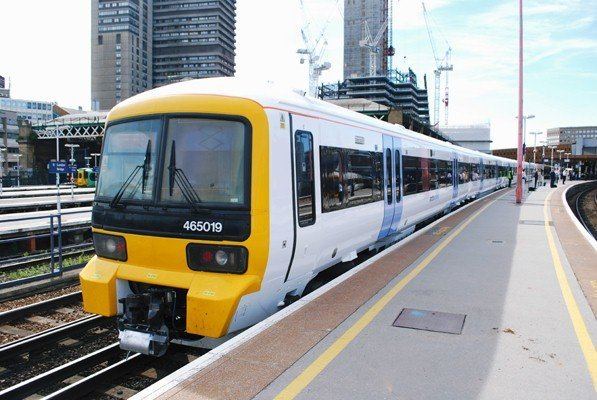Constructed 1991 - 1994 | ||
 | ||
In service 13 October 1992 - Current Replaced Class 415Class 416Class 423 Refurbishment 2005 (465/9 at Wabtec Rail, Doncaster)2010 - 2012/15 | ||
The British Rail Class 465 Networker electric multiple units were built by GEC Alsthom (Metro-Cammell) and BREL between 1991 and 1993, and by ABB Rail between 1993 and 1994. They were brought into service from 1992 and operated by British Rail until 1997, then by Connex until 2003, South Eastern Trains until 2006 and then Southeastern to the present day.
Contents
They are mostly used on suburban routes serving the South East of England, although they have also been occasionally spotted elsewhere throughout Kent including the Kent Coast Line which is normally operated by Class 375 Electrostar trains.
History of the class
Network SouthEast began the planning for the development of the Class 465 Networker in 1988, and invited a tender for 710 of the units to be built. The Class 465 was introduced in order to replace the 41-year-old Class 415 (4EPB) EMUs.
All trains were originally supplied in Network SouthEast livery and branded "Kent Link Networker". Some units were re-liveried in the first Connex South Eastern livery. All 465/0, 465/1, 465/2, 465/9 and 466 trains are now in the white and charcoal livery of Southeastern with blue doors.
Two manufacturers
Both manufacturers' units look exceptionally similar in design; the major noticeable differences for passengers are the lack of aircraft-style overhead air vents on those produced by GEC Alsthom (465/2), and the BREL (465/0) and ABB (465/1) units also feature slightly different dot matrix displays on the front and rear of the train to show the route number and destination, compared to the GEC Alsthom units. There are other visible but minor differences in door switches and audible chimes, window shapes and exterior panelling amongst the fleet.
In addition, the two units employ different traction motors, which sound different. Despite the differences though, the units can be used interchangeably. Particularly during peak times when longer trains are used, it is quite common to see a train comprising two four car units, one from each batch. Both classes share many similarities with the later dual-voltage Class 365, and are also similar in design to the diesel Class 165. When first introduced, all seating was standard class only. Although the units are interoperable, the spare parts for the different units are different.
The maximum speed of a Class 465 Networker is 75 mph (120 km/h) and they are designed only for 750 V DC third rail operation. A Solid State Traction Converter package controls 3-phase AC Traction motors, which allows for Rheostatic or Regenerative Dynamic braking. Primary braking system is Electro-pneumatically actuated disc brakes, which is blended with the Dynamic brakes. Tachometers on every axle of the unit provide for Wheel Slip/Slide Protection. A solid state Auxiliary Converter provides 110 V DC and 240 V AC supplies; this is the source of the loud buzzing noise which can be heard when the train is stationary. On a BREL the Aux Converter is located on the TSO, whereas on the GEC Alsthom there is one each on the TSO and TSOL.
Traction equipment replacement
In 2007, plans were drawn up to improve reliability of the BREL, ABB built units (Class 465/0 and 465/1) by the installation of new traction equipment. The new package, commissioned by Southeastern and HSBC Rail was developed by Hitachi Rail who also developed the Class 395, was retrofitted across Southeastern's 97 trains over the course of 2009 - 2010. Brush, the suppliers / manufacturers of the original traction equipment worked as consultants to assist in retro-fitting the new equipment. The first example to re-enter service was 465181, which rolled out in March 2009. The units with the new equipment are easily recognisable, because they sound similar to the Class 395.
Refurbishment
In 2005, 34 465/2 units (465201-465234) were given an extensive refurbishment. This included new interior panelling, new flooring, new lighting, new seat moquette (in the same grey and blue design as on the Class 375 Electrostars), and the addition of a new first class seating area at the front and rear of the units, amongst other changes. This was done with the intention that they would be cascaded to the outer-suburban routes alongside the Class 375's and to be replaced by the Class 376 on inner suburban services. They were reclassified as a separate sub-fleet designated 465/9 (465901-465934) and to replace the life expired Class 423 4 VEP slam door stock which came to an end of their useful lives on outer suburban services to Kent and which did not meet up with modern health and safety requirements and which finally was withdrawn in October 2005.
From 2010, the whole of the class 465/466 saw another refresh, with new seating covers and Advertisement posters.
The Class 465/0s & Class 465/1s were repainted at Railcare Wolverton into Southeastern's new livery which consisted of Lilac Doors, Midnight blue equipment covers and a Midnight blue band where the Grey/Silver one used to be. In the first few months of this process the 465s were returned in a plain livery consisting of just lilac doors, but 465025 was the first unit to return with the Midnight blue band but the equipment covers remained white. It wasn't until 465151 was returned in early 2011 that we saw the complete livery which now seems to be standard. Since December 2010, the 465s have been returned to Slade Green Depot on a weekly basis and sent up to Wolverton on this basis as well. This process occurred every Saturday. This process was finished on 21 May 2012 once all the 465/0/1s had been repainted. The last 465 to be repainted '465014', had been taken to Railcare, Wolverton on 28 April 2012.
